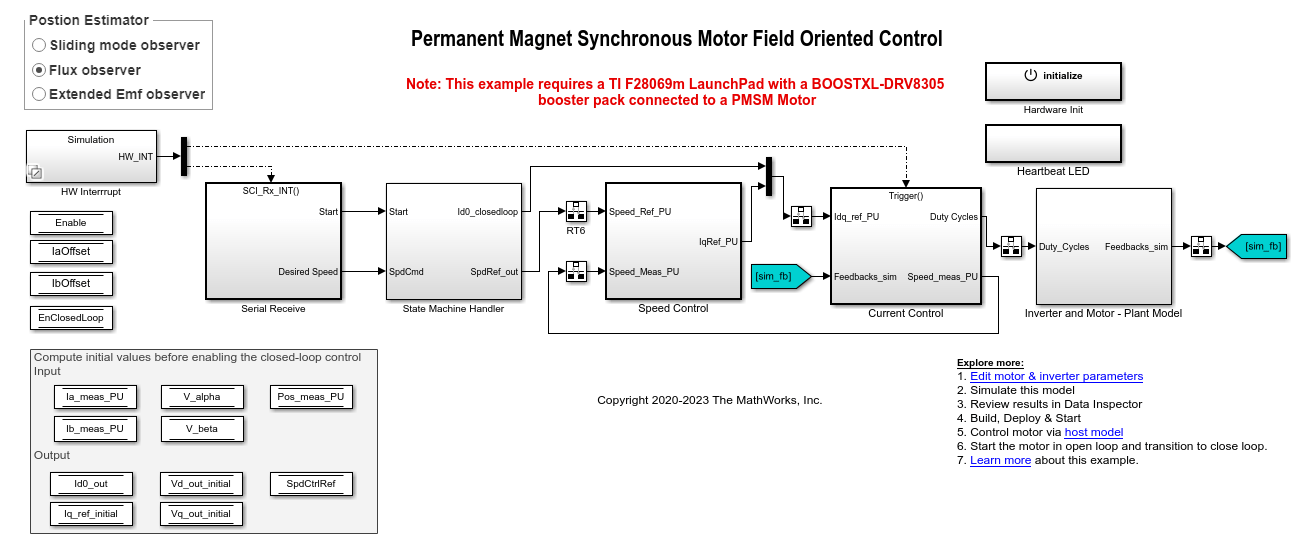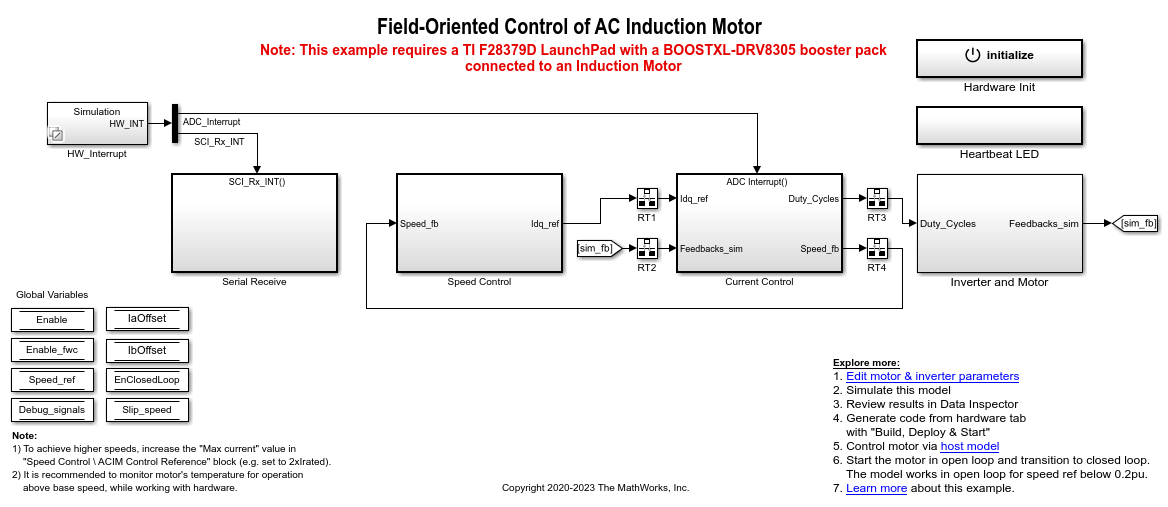Flux Observer
计算转子的电气位置、磁通量和电转矩
库:
Motor Control Blockset HDL Support /
Sensorless Estimators
Motor Control Blockset /
Sensorless Estimators
描述
Flux Observer 模块使用静止 αβ 参考系中沿 α- 轴和 β 轴的标幺单位电压和电流值,计算表贴式永磁同步电机 (SPMSM) 或感应电机的电气位置、磁通量和电转矩。
该模块还接受 16 位定点数据类型输入。为了对 16 位定点数据类型信号执行数学运算,该模块使用优化的方程实现来保持最佳精度。
此外,您还可以使用高级选项来启用 ParameterBus 输入端口,该端口可与 Compute Parameter 模块结合使用,以便在运行时以最佳方式更新模块参数。当电机参数可能随时间变化时(例如,构建可能需要在运行时更换电机的应用时),您可以使用此功能。
方程
以下方程描述模块如何在 αβ 参考系中计算 SPMSM 的电气位置、磁通量和电转矩。
如果 且
则以下拉普拉斯变换表示在 Ψα 和 Ψβ 中可用的积分项:
该模块使用基于低通滤波器 (LPF) 的积分器来计算这些积分项。
如果电机的输入电角速度 (ωe) 远大于对应于基于 LPF 的积分器的截止频率的速度 (ωc),则
基于 LPF 的积分器不允许任何 DC 偏移(在模块输入中)使模块输出逐渐增加。例如,假设有一个与阶跃输入 x(t) = k*u(t) 对应的输入函数 X(s)=k/s。使用基于 LPF 的积分器的前述传递函数 ,我们得到:
根据上一方程,LPF 积分器的阶跃响应会渐近稳定于 DC 值(取决于阶跃输入的幅值)。而纯积分器的阶跃响应是斜坡函数。在 LPF 积分器输出端使用高通滤波器可以完全消除输入中的 DC 偏移。
下列方程描述该模块如何计算感应电机的转子电气位置、转子磁通量和电转矩。
其中:
和 是 α 轴和 β 轴电压(伏特)。
和 是 α 轴和 β 轴电流(安培)。
是电机的定子电阻 (ohm)。
是电机的定子电感(亨)。
是电机的转子电感(亨)。
是电机的磁化电感(亨)。
是感应电机的总漏磁因子。
是电机极对数。
是转子磁通量(韦伯)。
和 是沿 α 轴和 β 轴的转子磁通量(韦伯)。
是转子的电转矩 (Nm)。
是转子的电气位置(弧度)。
示例
端口
输入
输出
参数
参考
[1] A. Podder and D. Pandit, "Study of Sensorless Field-Oriented Control of SPMSM Using Rotor Flux Observer & Disturbance Observer Based Discrete Sliding Mode Observer," 2021 IEEE 22nd Workshop on Control and Modelling of Power Electronics (COMPEL), 2021, pp. 1-8. (doi: 10.1109/COMPEL52922.2021.9645939)
[2] O. Sandre-Hernandez, J. J. Rangel-Magdaleno and R. Morales-Caporal, "Simulink-HDL cosimulation of direct torque control of a PM synchronous machine based FPGA," 2014 11th International Conference on Electrical Engineering, Computing Science and Automatic Control (CCE), Campeche, 2014, pp. 1-6. (doi: 10.1109/ICEEE.2014.6978298)
[3] Y. Inoue, S. Morimoto and M. Sanada, "Control method suitable for direct torque control based motor drive system satisfying voltage and current limitations," The 2010 International Power Electronics Conference - ECCE ASIA -, Sapporo, 2010, pp. 3000-3006. (doi: 10.1109/IPEC.2010.5543698)
扩展功能
版本历史记录
在 R2020a 中推出


